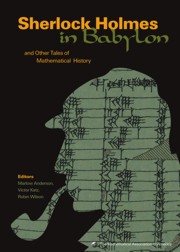Book contents
- Frontmatter
- Introduction
- Contents
- Ancient Mathematics
- Medieval and Renaissance Mathematics
- The Seventeenth Century
- Foreword
- An Application of Geography to Mathematics: History of the Integral of the Secant
- Some Historical Notes on the Cycloid
- Descartes and Problem-Solving
- René Descartes' Curve-Drawing Devices: Experiments in the Relations Between Mechanical Motion and Symbolic Language
- Certain Mathematical Achievements of James Gregory
- The Changing Concept of Change: The Derivative from Fermat to Weierstrass
- The Crooked Made Straight: Roberval and Newton on Tangents
- On the Discovery of the Logarithmic Series and Its Development in England up to Cotes
- Isaac Newton: Man, Myth, and Mathematics
- Reading the Master: Newton and the Birth of Celestial Mechanics
- Newton as an Originator of Polar Coordinates
- Newton's Method for Resolving Affected Equations
- A Contribution of Leibniz to the History of Complex Numbers
- Functions of a Curve: Leibniz's Original Notion of Functions and Its Meaning for the Parabola
- Afterword
- The Eighteenth Century
- Index
- About the Editors
On the Discovery of the Logarithmic Series and Its Development in England up to Cotes
from The Seventeenth Century
- Frontmatter
- Introduction
- Contents
- Ancient Mathematics
- Medieval and Renaissance Mathematics
- The Seventeenth Century
- Foreword
- An Application of Geography to Mathematics: History of the Integral of the Secant
- Some Historical Notes on the Cycloid
- Descartes and Problem-Solving
- René Descartes' Curve-Drawing Devices: Experiments in the Relations Between Mechanical Motion and Symbolic Language
- Certain Mathematical Achievements of James Gregory
- The Changing Concept of Change: The Derivative from Fermat to Weierstrass
- The Crooked Made Straight: Roberval and Newton on Tangents
- On the Discovery of the Logarithmic Series and Its Development in England up to Cotes
- Isaac Newton: Man, Myth, and Mathematics
- Reading the Master: Newton and the Birth of Celestial Mechanics
- Newton as an Originator of Polar Coordinates
- Newton's Method for Resolving Affected Equations
- A Contribution of Leibniz to the History of Complex Numbers
- Functions of a Curve: Leibniz's Original Notion of Functions and Its Meaning for the Parabola
- Afterword
- The Eighteenth Century
- Index
- About the Editors
Summary
To the expert of today the logarithmic series appears to be a very non-essential detail. In its time it was a very notable discovery as regards itself alone, as well as in the framework of the general theory of series. It was discovered circa 1667 by Newton and independently by Mercator. Huygens and Gregory were close to the same discovery but they were anticipated by the other two. Newton was then 24 years old, Mercator 47. For Newton the logarithmic series was a beginning, for Mercator the climax.
Nicolas Mercator
(1620-1687)
Mercator's life work is almost forgotten today, certainly unjustly. Mercator was a distinguished mathematician, physicist and astronomer. Shortly after his arrival in London the much-traveled man was received into the Royal Society. Products of that period are his new astronomical theory [10], the edition of Euclid [11], the navigation problems [12] and the calculation of logarithms [13]. We shall be concerned here with the latter.
The Logarithmo-technia is divided into three very unequal parts. The first two sections, which had already been published separately in 1667, are devoted entirely to the calculation of a system of common logarithms. In the presentation of logarithms Mercator proceeds very intuitively and clearly according to the then generally customary usage. He divides the number domain between 1 and 10 by insertion of geometric means (he calls them ratiunculae) into 10 million parts. Thus the logarithm of a number between 1 and 10 is determined from the number of ratiunculae between 1 and this number.
- Type
- Chapter
- Information
- Sherlock Holmes in BabylonAnd Other Tales of Mathematical History, pp. 235 - 239Publisher: Mathematical Association of AmericaPrint publication year: 2003
- 1
- Cited by



